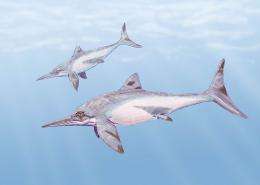Ichthyosaur Platypterygius kiprijanovi. Image credit: Wikimedia Commons
(PhysOrg.com) -- New evidence shows that reptiles roaming the oceans at the time of the dinosaurs could maintain a constant body temperature well above that of the surrounding water.
"It's great that this can be tested," said Professor Ryosuke Motani, a paleontologist at the UC Davis Department of Geology, referring to the technique for measuring body temperatures of extinct animals developed by French scientists. "We can now apply this test to study the evolution of ichthyosaurs, plesiosaurs and other marine reptiles."
Motani wrote a "Perspective" article for the June 11 issue of the journal Science to accompany a paper, by Aurelien Bernard and colleagues at the Universite Lyon, France, describing their work with the "fish tooth thermometer."
Bernard and colleagues measured oxygen isotopes in fossil teeth to estimate the body temperatures of extinct animals. Oxygen is present in the atmosphere mostly as oxygen-16 and also as oxygen-18. Animals incorporate both forms into their bones and teeth as they grow, but the ratio of oxygen-16 to 18 taken up varies depending partly on temperature.
The researchers first looked at teeth from fossil fish. Assuming that, like modern fish, these were cold-blooded, the temperature signal from their teeth should match that of the sea water in which they lived. The researchers then used this "fish tooth thermometer" to look at teeth from fossil marine reptiles: ichthyosaurs, plesiosaurs and mosasaurs.
Ichthyosaurs were dolphinlike animals that probably cruised in deep water. Plesiosaurs had long necks and four flippers, and swam rather like a sea lion. Mosasaurs probably lived close to the coast and ambushed their prey. All three groups flourished between 250 and 65 million years ago.
Ichthyosaurs and plesiosaurs both had body temperatures well above their surroundings, Bernard and colleagues found. Mosasaurs' body temperature appeared to track with water temperature.
However, Bernard's results give water temperatures that are very high, Motani said -- as high as 39 degrees Celsius (102 F), a temperature at which modern fish and marine reptiles could not grow.
The fish-tooth thermometer might be thrown off because the percentage of oxygen-18 in the atmosphere has changed over millennia, Motani said. When he corrected for this, the ichthyosaur body temperature came down to about 24 degrees Celsius (75 F). That's a good fit with living animals, Motani said.
Some modern marine animals are also homeothermic, meaning that they regulate their body temperature. Leatherback turtles can maintain a constant core temperature because they are very large and have a layer of blubber. Tuna have a high metabolic rate compared to other fish, giving them a higher body temperature.
Ichthyosaurs and plesiosaurs may have used similar strategies, Motani said. The conclusion that these animals could maintain a steady body temperature also fits with what we know about these animals -- that they were active and cruising in the open seas rather than lurking in shallower water.
Motani hopes to use the new approach to understand the evolution of marine reptiles from lizards to dolphinlike animals. At the time ichthyosaurs evolved, there was a drastic drop in sea levels and a loss of shallow coastal waters.
"They didn't start off homeothermic (able to maintain a steady body temperature), they probably evolved homeothermy as they became more fish-shaped -- now we can test that hypothesis," he said.
Provided by UC Davis




















